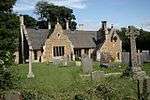Hough-on-the-Hill
Hough-on-the-Hill is a village and civil parish in the South Kesteven district of Lincolnshire, England. The population of the civil parish including Brandon was 399 at the 2011 census.[1] It is situated approximately 7 miles (11 km) due north from the market town of Grantham. The hamlets of Gelston and Brandon are part of the parish. Hough-on-the-Hill is on a significant rise, hence the name.
| Hough on the Hill | |
|---|---|
All Saints' Church, Hough on the Hill | |
 Hough on the Hill Location within Lincolnshire | |
| Population | 399 (2011) |
| OS grid reference | SK9246 |
| • London | 105 mi (169 km) S |
| District | |
| Shire county | |
| Region | |
| Country | England |
| Sovereign state | United Kingdom |
| Post town | GRANTHAM |
| Postcode district | NG32 |
| Dialling code | 01400 |
| Police | Lincolnshire |
| Fire | Lincolnshire |
| Ambulance | East Midlands |
| UK Parliament | |
History
The name Hough is Old English "haga", or 'enclosure'.[2]
The village is listed in the Domesday Book of 1086 as "Hag" and "Hache", comprising 45 households, four mills and a church.[3] It is not clear when the 'le Hill' or 'on the Hill' suffix was added.
An extensive Anglo-Saxon cemetery including both burials and cremations has been excavated on Lovedon Hill.[4]
There was also a Medieval Motte-and-bailey castle situated on a natural mound, known as Castle Hill, on which the church of All Saints was later built. It is an ancient scheduled monument.[5][6]
Hough Priory was located here, dependent on the Augustinian Abbey of Notre Dame du Voeu Cherburg; it was founded about 1164 and dissolved in about 1414. In 1432 it was granted to the Carthusian order of Mountgrace.[7] There are no remains.[8]
Landmarks
The Grade I listed church, which is dedicated to All Saints, is built of ironstone and limestone and dates back to the 11th century. It was restored in 1845. It contains monuments to the Payne family and is notable for its Saxon tower with an unusual circular stairway. The top storey of the tower was added during the 15th century.[9][10]
The post office is a Grade II listed 17th century shop with house attached, built of ironstone and red brick.[11]

The Grade II listed Brownlow Arms public house was built in 1852 of ironstone and limestone.[12]
The old school and schoolhouse were built in 1867[13] on the site of the medieval castle but they are outside of the present scheduled area.[6]
References
- "Civil parish population 2011". Neighbourhood Statistics. Office for National Statistics. Retrieved 23 April 2016.
- Mills, Anthony David (2003); A Dictionary of British Place Names, Oxford University Press, revised edition (2011), p. 248. ISBN 019960908X
- Hough on the Hill in the Domesday Book. Retrieved 27 July 2011.
- Historic England. "Anglo Saxon Cemetery, Hough on the Hill (325833)". PastScape. Retrieved 27 July 2011.
- Historic England. "Motte and bailey castle, Hough on the Hill (325849)". PastScape. Retrieved 27 July 2011.
- Historic England. "Motte and bailey castle, Hough on the Hill (1003571)". National Heritage List for England. Retrieved 27 July 2011.
- "Alien Houses - The Priory of Hough". A History of the County of Lincoln Vol II. Victoria County History. Retrieved 28 July 2011.
- Historic England. "Hough Priory (325841)". PastScape. Retrieved 27 July 2011.
- Historic England. "All Saints Church, Hough on the Hill (1360316)". National Heritage List for England. Retrieved 27 July 2011.
- Historic England. "All Saints Church, Hough on the Hill (325846)". PastScape. Retrieved 27 July 2011.
- Historic England. "Post Office (1146610)". National Heritage List for England. Retrieved 27 July 2011.
- Historic England. "Brownlow Arms (1062377)". National Heritage List for England. Retrieved 27 July 2011.
- Historic England. "School (1308909)". National Heritage List for England. Retrieved 27 July 2011.
External links

- Hough on the Hill Genuki.org.uk. Retrieved 14 April 2011
- Loveden website for local villages